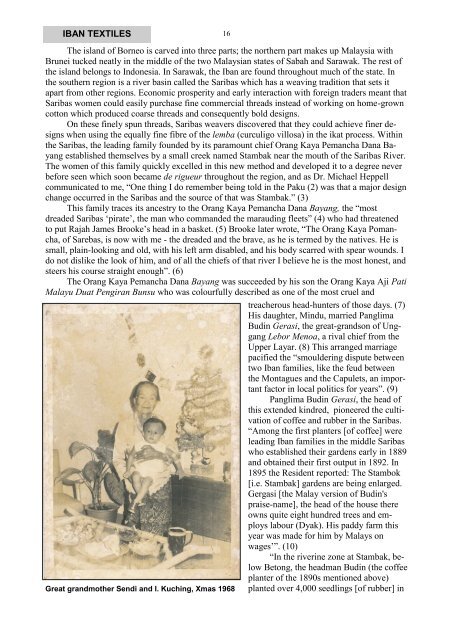download - OATG. Oxford Asian Textile Group
download - OATG. Oxford Asian Textile Group
download - OATG. Oxford Asian Textile Group
- No tags were found...
Create successful ePaper yourself
Turn your PDF publications into a flip-book with our unique Google optimized e-Paper software.
IBAN TEXTILES16The island of Borneo is carved into three parts; the northern part makes up Malaysia withBrunei tucked neatly in the middle of the two Malaysian states of Sabah and Sarawak. The rest ofthe island belongs to Indonesia. In Sarawak, the Iban are found throughout much of the state. Inthe southern region is a river basin called the Saribas which has a weaving tradition that sets itapart from other regions. Economic prosperity and early interaction with foreign traders meant thatSaribas women could easily purchase fine commercial threads instead of working on home-growncotton which produced coarse threads and consequently bold designs.On these finely spun threads, Saribas weavers discovered that they could achieve finer designswhen using the equally fine fibre of the lemba (curculigo villosa) in the ikat process. Withinthe Saribas, the leading family founded by its paramount chief Orang Kaya Pemancha Dana Bayangestablished themselves by a small creek named Stambak near the mouth of the Saribas River.The women of this family quickly excelled in this new method and developed it to a degree neverbefore seen which soon became de rigueur throughout the region, and as Dr. Michael Heppellcommunicated to me, ―One thing I do remember being told in the Paku (2) was that a major designchange occurred in the Saribas and the source of that was Stambak.‖ (3)This family traces its ancestry to the Orang Kaya Pemancha Dana Bayang, the ―mostdreaded Saribas ‗pirate‘, the man who commanded the marauding fleets‖ (4) who had threatenedto put Rajah James Brooke‘s head in a basket. (5) Brooke later wrote, ―The Orang Kaya Pomancha,of Sarebas, is now with me - the dreaded and the brave, as he is termed by the natives. He issmall, plain-looking and old, with his left arm disabled, and his body scarred with spear wounds. Ido not dislike the look of him, and of all the chiefs of that river I believe he is the most honest, andsteers his course straight enough‖. (6)The Orang Kaya Pemancha Dana Bayang was succeeded by his son the Orang Kaya Aji PatiMalayu Duat Pengiran Bunsu who was colourfully described as one of the most cruel andtreacherous head-hunters of those days. (7)His daughter, Mindu, married PanglimaBudin Gerasi, the great-grandson of UnggangLebor Menoa, a rival chief from theUpper Layar. (8) This arranged marriagepacified the ―smouldering dispute betweentwo Iban families, like the feud betweenthe Montagues and the Capulets, an importantfactor in local politics for years‖. (9)Panglima Budin Gerasi, the head ofthis extended kindred, pioneered the cultivationof coffee and rubber in the Saribas.―Among the first planters [of coffee] wereleading Iban families in the middle Saribaswho established their gardens early in 1889and obtained their first output in 1892. In1895 the Resident reported: The Stambok[i.e. Stambak] gardens are being enlarged.Gergasi [the Malay version of Budin'spraise-name], the head of the house thereowns quite eight hundred trees and employslabour (Dyak). His paddy farm thisyear was made for him by Malays onwages‘‖. (10)―In the riverine zone at Stambak, belowBetong, the headman Budin (the coffeeplanter of the 1890s mentioned above)Great grandmother Sendi and I. Kuching, Xmas 1968 planted over 4,000 seedlings [of rubber] in
















